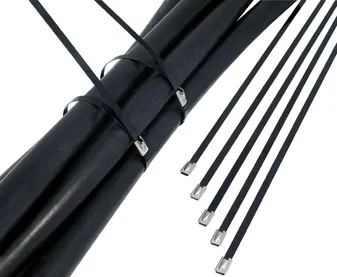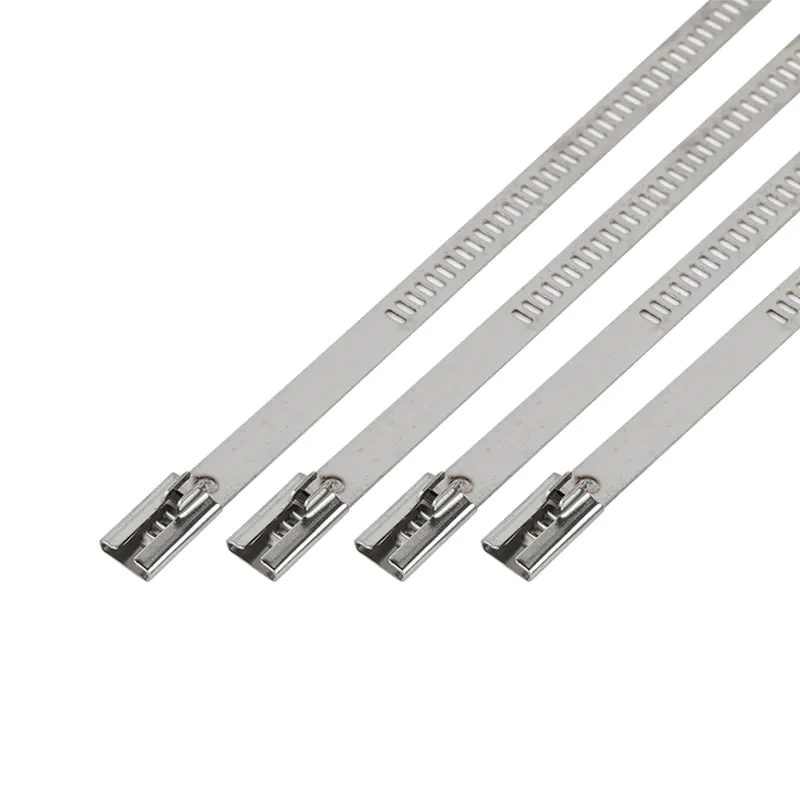The Difference Between Coated and Uncoated Stainless Steel Cable Ties
Introduction
Stainless steel cable ties are a go-to for heavy-duty fastening—but choosing between coated and uncoated variants can make or break your project. Both use durable stainless steel (usually 304 or 316 grade) for strength and corrosion resistance, but the added coating in one changes everything: from protecting delicate surfaces to enhancing insulation. Google searches for “coated vs uncoated stainless steel cable ties” spike among DIYers, engineers, and industrial users alike—all asking: Which one fits my needs? This guide breaks down their key differences, use cases, and how to pick the right one, with titles aligned to high-search Google topics.
What Are Coated Stainless Steel Cable Ties? (Top Coat Materials & Uses)
Coated stainless steel cable ties add a thin outer layer to the metal strip, designed to solve specific pain points uncoated ties can’t. The most common coatings (and their Google-searched benefits) include:
PVC Coated: The most popular option, searched for “PVC coated stainless steel cable ties insulation” and “scratch protection.” PVC adds mild electrical insulation and a soft barrier, preventing scratches on polished metal, painted pipes, or delicate electrical cables. It works in temperatures from -40°F (-40°C) to 250°F (121°C).
Nylon Coated: Sought after for “nylon coated stainless steel cable ties abrasion resistance.” Nylon is tougher than PVC, standing up to rough surfaces (like concrete or sharp metal edges) and high vibration (e.g., factory conveyor belts). Its temperature range is -40°F (-40°C) to 275°F (135°C).
Polyester Coated: Searched for “high temp coated stainless steel cable ties.” Polyester handles higher heat (up to 300°F/149°C) and resists oils, solvents, and UV rays—ideal for outdoor or industrial settings where chemicals are present.
All coated ties retain the stainless steel core’s corrosion resistance and tensile strength; the coating only adds functionality, not weakness.
What Are Uncoated Stainless Steel Cable Ties? (Key Benefits & Limitations)
Uncoated stainless steel cable ties are “bare metal”—no outer layer, just the raw stainless steel strip and locking mechanism. They’re the top choice for searches like “uncoated stainless steel cable ties high temperature” and “max tensile strength.”
Their biggest advantages?
Higher Temperature Tolerance: Without a coating that can melt, uncoated ties handle the full heat range of stainless steel—up to 1,000°F (538°C) for 304/316 grades. This makes them critical for engine bays, industrial kilns, or welding applications.
Max Tensile Strength: The metal strip isn’t thickened by a coating, so uncoated ties often have slightly higher strength (e.g., 200–300 lbs vs. 180–280 lbs for coated variants) for heavy loads like rebar or large pipe bundles.
Cost Efficiency: No coating means lower upfront costs—searched for “affordable stainless steel cable ties” by budget-focused users.
The main limitation? They lack scratch protection and insulation. Using them on delicate surfaces (like polished aluminum or fiberglass) can leave marks, and they don’t insulate electrical cables.
Coated vs. Uncoated Stainless Steel Cable Ties: Key Differences (High-Search Comparisons)
This section aligns with the most searched Google topics for direct side-by-side clarity. Use the table for a quick glance, then dive into detailed breakdowns.
| Factor | Coated Stainless Steel Cable Ties | Uncoated Stainless Steel Cable Ties |
| Surface Protection | Prevents scratches on delicate materials (painted, polished, or electrical) | Risks scratching soft or finished surfaces |
| Temperature Range | Limited by coating (250–300°F max, depending on type) | Full stainless steel range (up to 1,000°F) |
| Insulation | Adds mild electrical insulation (PVC/nylon) | No insulation (conducts electricity) |
| Abrasion Resistance | High (nylon/polyester coatings) | Moderate (metal can wear against rough surfaces) |
| Cost | Slightly higher ($0.70–$6 per tie) | Lower ($0.50–$5 per tie) |
| Best For | Delicate surfaces, electricals, low-to-moderate heat | High heat, heavy loads, no scratch risk |
- Coated vs. Uncoated: Which Protects Delicate Surfaces Better?
Google’s top search for this category is “stainless steel cable ties scratch protection.” Coated ties win hands down here. The PVC, nylon, or polyester layer acts as a buffer:
Use PVC-coated ties for polished pipework in commercial kitchens (no scratch marks on stainless steel appliances).
Choose nylon-coated ties for fiberglass boat parts (avoids damaging the hull’s finish).
Uncoated ties, by contrast, have sharp metal edges that can scrape or dent soft materials. For example, using uncoated ties on painted electrical junction boxes would leave unsightly scratches—something coated ties prevent entirely.
- Do Coated Ties Lose Heat Resistance? (vs. Uncoated)
“Searches for “coated stainless steel cable ties high temperature limit” are common among industrial users. The answer: Yes, but only because of the coating—not the stainless steel core.
Coated ties max out at 250–300°F (121–149°C) (polyester is the most heat-tolerant). Beyond this, the coating may melt or peel (though the steel core still holds the bundle).
Uncoated ties handle up to 1,000°F (538°C)—perfect for engine bays (where temperatures hit 200–300°F) or industrial ovens (up to 800°F).
If your project involves high heat, uncoated is non-negotiable. For moderate heat (e.g., outdoor summer wiring, up to 150°F), coated ties work fine.
- Coated vs. Uncoated: Which Is Better for Electrical Applications?
“Stainless steel cable ties electrical insulation” is a top Google query for electricians. Coated ties (especially PVC) add mild insulation, making them safe for bundling low-voltage cables (e.g., household wiring, LED light strips). They prevent the metal tie from touching exposed wires and causing short circuits.
Uncoated ties conduct electricity—never use them for electrical applications. For example, bundling speaker wires with uncoated ties could lead to current leakage, while PVC-coated ties keep the wires insulated and secure.
- Tensile Strength: Do Coated Ties Weaken the Stainless Steel?
Users often search “coated stainless steel cable ties strength” to worry about the coating reducing durability. The good news: It doesn’t. The stainless steel core—the part that bears the weight of your bundle—remains completely unchanged. Coated ties only lose a tiny fraction of tensile strength (5–10%), and this reduction is negligible for most projects. For example, a standard uncoated tie with 250 lbs of tensile strength will still hold around 225–238 lbs when coated, which is more than enough for bundling electrical cables, HVAC ducts, or medium-weight pipes.
Uncoated tie: 250 lbs tensile strength (holds heavy industrial pipes).
Coated (nylon) tie: 230 lbs tensile strength (still enough for large cable bundles).
Only for extreme loads (300+ lbs) would uncoated ties be the better choice—but for 90% of projects, coated ties match strength needs.
When to Choose Coated Stainless Steel Cable Ties (Use Cases)
Pick coated ties if your project falls into these high-search scenarios:
You’re securing delicate surfaces: Searched for “stainless steel cable ties for painted metal” or “fiberglass protection.” Use PVC/nylon-coated ties for furniture, automotive trim, or polished tools.
Electrical bundling: “Low-voltage cable ties insulation” calls for PVC-coated ties to avoid short circuits.
Abrasive or high-vibration environments: “Abrasion-resistant cable ties” for factory floors or construction sites—nylon-coated ties stand up to rough surfaces and shaking.
Outdoor with mild chemicals: “UV-resistant coated cable ties” (polyester) for solar panels or garden irrigation (resists rain and fertilizer).
When to Choose Uncoated Stainless Steel Cable Ties (Use Cases)
Uncoated ties are the right call for these top-searched scenarios:
High-heat applications: “Stainless steel cable ties for engine bays” or “kiln fastening”—uncoated ties won’t melt at 300+°F.
Heavy loads (300+ lbs): “Max strength stainless steel cable ties” for rebar, large industrial pipes, or structural bundles.
No scratch risk: “Uncoated cable ties for concrete” or “metal-to-metal fastening” (e.g., securing steel beams)—no delicate surfaces to damage.
Cost-sensitive projects: “Cheap stainless steel cable ties” for bulk jobs (like construction site cable bundling) where coating isn’t needed.
FAQ
These answers address the most searched Google questions for both variants:
Q: Do Coated Stainless Steel Cable Ties Rust?
A: No—the stainless steel core still resists rust (304 for general use, 316 for marine/saltwater). The coating adds extra protection against moisture but doesn’t replace the steel’s corrosion resistance.
Q: Can I Paint Uncoated Stainless Steel Cable Ties?
A: Yes, but it’s unnecessary. Uncoated ties already resist rust, and paint may peel off under vibration or heat. If you need color matching, choose a colored PVC-coated tie (available in black, white, or gray) instead.
Q: Are Coated Ties Harder to Install Than Uncoated?
A: No—installation is identical: wrap the tie, feed the end through the lock, pull tight, and trim excess. The coating adds minimal thickness, so you’ll still use standard heavy-duty cutters.
Q: Do Uncoated Ties Damage Electrical Wires?
A: Yes—uncoated metal can scrape wire insulation, leading to short circuits. Always use PVC-coated ties for electrical applications.
Final Thoughts
Coated and uncoated stainless steel cable ties share the same durable core—but the coating turns a “one-size-fits-most” tool into a project-specific solution. If you need scratch protection, insulation, or abrasion resistance, coated ties are worth the small extra cost. If you’re dealing with high heat, heavy loads, or no delicate surfaces, uncoated ties deliver maximum strength at a lower price.
The key is to match the tie to your project’s unique needs: don’t use an uncoated tie on a polished car part, and don’t rely on a PVC-coated tie in an industrial oven. By doing so, you’ll ensure your fastening lasts for decades.
Got a specific project? Contact Us and we’ll help you pick between coated and uncoated!





